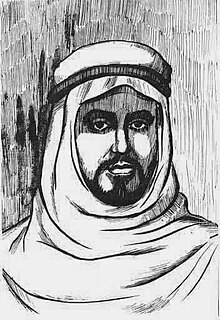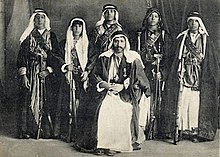

| Anizah | |
|---|---|
| Adnanite | |
| Ethnicity | Arab |
| Nisba | Anezī |
| Location | Saudi Arabia, Kuwait, Bahrain, Qatar, Iraq, Syria, Jordan, Lebanon, Egypt, Palestine and the United Arab Emirates. |
| Descended from | Anizah Ibn Asad Ibn Rabīʿa Ibn Nizar Ibn Ma’ad Ibn Adnan.[1] |
| Parent tribe | Rabīʿa |
| Religion | Islam |
AnizahorAnazah[2] (Arabic: عنزة, romanized: ʻanizah, Najdi pronunciation: [ʕni.zah]) is an Arabian tribe in the Arabian Peninsula, Upper Mesopotamia, and the Levant.

Anizah's existence as an autonomous tribal group, like many prominent modern tribes, predates the rise of Islam in the seventh century. The classical Arab genealogists placed Anizah within the large Rabiʿa branch of the Adnanites alongside the tribes of Abd al-Qays, Banu Bakr, Bani Hanifa, and Taghlib. In the genealogical scheme, Anizah's eponymous ancestor is a great uncle of all of these.
Two main branches of Anizah are recorded by the early Muslim scholars. One branch was nomadic, living in the northern Arabian steppes bordering Syria and Mesopotamia. The other, known as Bani Hizzan, was sedentary, living within the wadis of the district of Al-Yamama in eastern Najd, just south of their purported cousins, the Bani Hanifa of the Abu Bakr, who inhabited modern-day Riyadh. Families tracing their origin to Anizah through Hizzan still exist in that area today.[3]
The other tribes of Rabiʿa were far more prominent in the events of late pre-Islamic Arabia and the early Islamic era. According to historians such as al-Tabari (10th century), the Anizah joined with Bakr ibn Wa'il under an alliance they called al-Lahazim. Many of these tribes were followers of the Christian faith prior to Islam. Others such as bani Taghlib remained largely Christian even after the Muslim conquest of Mesopotamia and the Levant.
Bahrain's House of Khalifa and Kuwait's House of Sabah royal families both trace their ancestry to this vast tribe.[4] Saudi Arabia's House of Saud trace their ancestry to Anizah's cousin tribe, the Bani Hanifa,[5] which has merged with the larger tribe Anizah, and are therefore considered members of it as well.[6]

According to the historians Abu'l-Hasan Bayhaqi and Ibn Sa'id al-Maghribi, the Anizah tribe settled in the Hijaz region, specifically in Khaybar, at the end of the 10th century AD.[7][8] Ali bin al Mugrab Al Uyuni mentioned the news of the Anizah tribe fighting rulers of Khaybar, al Jaafar al-Tayyar and expelled them from it.[9] With the passage of time, a part of the Anizah become urban, while the other part remained on the nomadic lifestyle.

The modern tribe of Anizah became prominent in the Ottoman era, as masters of the oasis towns of northwestern Arabia, particularly Khaybar and Al-'Ula. Although not farmers themselves, the Anizah levied crops from the inhabitants, and only spent the winter months in the area, while migrating northwards into southern Syria in the summer months, where they collected tribute from the inhabitants of the Hawran region. The tribute was known as khuwwa ("brotherhood"), and in exchange, the tribesmen pledged to protect the farmers from other tribes. Other clans of the tribe spread across the northern Arabian steppes as far north and east as the Euphrates. According to Encyclopedia of Islam, "it is not known whence they came", while many such as the Western travelers Philby and Anne Blunt simply assumed they had recently migrated from Nejd, having been pushed northwards into Syria by other tribes. However, the tribe does not appear in the historical or genealogical records of Nejd, and members of the tribe posit a migration from Syria and Iraq southwards to Nejd, which comports with the original lands of the Bakr ibn Wa'il. In particular, it is believed they originated from the area of Ayn Tamr in the Iraqi desert near Karbala. In the 19th century, the Swiss traveler Burckhardt and the British traveler Doughty visited the tribe in their stronghold of Khaybar and gathered from them many details of Bedouin life. Sheikh Medjuel el Mezrab of the Anizah was the husband of Lady Jane Digby.
One branch of the Anizah in that area, centered around Al-Jouf and the valley of Wadi Sirhan and extending into Jordan and Syria, became so large and powerful that it practically developed into an independent tribe, known as the Ruwallah. The Ruwallah engaged in battle with other branches of Anizah, and also became the arch-enemy of the large tribe of Shammar, who inhabited roughly the same area and dominated Nejd in the late 19th century after temporarily deposing the Al Saud. A 19th century oral poetic epic telling the tale of a rivalry between two heroes from Shammar and Anizah was published in 1992.[10] The Ruwallah were among the tribes that took part in the "Arab Revolt" against the Ottomans in 1916. Another northern branch of Anizah, the `Amarat, was centered in the deserts of Iraq.
Members of the Anizah tribe were displaced in the eighteenth century from the land of Najd to Iraq and from Iraq to Ahvaz, and they still live there[citation needed]
The sparse chronicles of Nejd relating to the pre-Wahhabi era relate a process of penetration of the tribe into northern and western Nejd, where they began to claim pastures during the winter months.[11] One 19th-century historian, Ibn La'bun, a descendant of Anizah who went by the tribal appellation of "Al-Wa'ili", recorded the story of the settlement of several `Annizi families in Nejd, which he placed in the 14th century CE. In the 15th century, the region of Al-Qassim in northern Nejd was being rapidly settled through migration and the majority of this activity was by members of Anizah. In the early 18th century the Bedouins of Anizah are recorded to have reached as far as the gates of Riyadh, killing its ruler in battle. This battle was part of a tribal war in which Riyadh and its neighboring villages took sides.
With the rise of the First Saudi State in the late 18th century, Anizah were among the tribes that adopted a favorable attitude towards this new power, but took little active part in supporting it militarily, due to their geographical location. The royal family of Saudi Arabia Al Saud family are from the 'Anizah tribe,[12] with Al Saud having ancestry from Wa'il, the region's native inhabitants as well as the migratory Anizah. The Saud intermarried with their 'Anizah rivals, al Shammar, along with other powerful tribes to solidify their dynasty. Ibn Saud sired dozens of children by his many wives. He had at most four wives at a time, divorcing many times, making sure to marry into many of the noble clans and tribes within his territory, including the chiefs of the Bani Khalid, Ajman, and Shammar tribes, as well as the Al ash-Sheikh.[13]
Sheikh Mashaan Ibn Hathal was a 19th-century cavalier, leader, and poet who gained his fame from leading the Tribe of Anizah across the Arabian peninsula and unifying it against the tribe's enemies at the Battle of Al Shimasiyah on 18 June 1825. Sheikh Mashaan died in the battle of Al Shimasiyah but the Anezis won consequently.[14]
Limited settlement of Bedouin tribesmen in nearby towns and villages has always been an ongoing process in the region. Settled families in Anizah are to be found not only in Saudi Arabia, where they are most numerous, but also in Kuwait, Jordan, Iraq, Syria, Lebanon, United Arab Emirates, Qatar, Oman, Bahrain, Ahwaz (Iran) and the West Bank, where the village of Anzah near Jenin is reportedly named after the tribe.
The establishment of the modern borders of the Middle East dealt a severe blow to the Bedouin lifestyle of tribes such as Anizah, which were accustomed to raising their animals over wide areas spanning many modern states. Special arrangements were made in the early 20th century for these tribes, but the vast majority ended up settling within these new states and taking Saudi, Kuwaiti, Iraqi, Lebanese, Syrian, or Jordanian citizenship. These recently settled tribesman are often distinguished from their sedentary cousins by retaining tribal appellations such as al-`Annizi or Al-Ruwaili as their surnames.
Among the tribe's members are:
The Anizah tribe is historically divided into urban and nomadic families, the most prominent of which are:
Several stories about the way Hathal obtained the Sheikhdom were told, however Ibn Abar a notable Anezi Historian believes that history tells us that Hathal came to power when Makkah's Sharif was unable to collect the zakat of one of the tribes near Makkah and was disturbed about it, here Sheikh Hathal emerged and pledged to the sheriff to bring him the zakat of this tribe, and in fact this was done for him, and from here he was appointed as a general sheikh of the tribe of Anizah and was given the seal and the bundle of Sheikhdom. Ibn Abar quoted on this saying :
"It is for the benefit of this narration that it is told from various perspectives with agreement and consensus on the cause and content, and it is for the purpose of collecting zakat from this tribe and bringing it to the Sharif, and we have the right to ask why sheikh Hathal pledged to carry out this mission. Did Sheikh Hathal have a personal contact with the Sharif, or did he have knowledge and connections with him? Was he the one who offered this service on his own initiative, or was it something that was brought to his attention? Why was the actual version of this story not kept in the same way over and over again? There are a lot of unanswered questions and mysterious occurrences around the circumstances of this case that we don't know about! There is no doubt, however, that the man was of enormous importance and presence among the people of his tribe, and that he was not an average person at the time, and that something like this prompted him to assume the Sheikhdom of this vast, great, and ancient tribe."
Hathal had two sons who were both considered Sheikhs : Sheikh Abdullah Ibn Hathal, and Sheikh Mndeel Al-Shuja' Or Mndeel the Brave. Their progeny are still regarded to be the Sheikhs of Anizah and are still given the honorary title of the Sheikhs of Shuyoukh of Anizah.
|
| |
|---|---|
These prefixes ignored in the alphabetical ordering: Al, Bani, Banu. | |
| |
Part of Arab tribes |